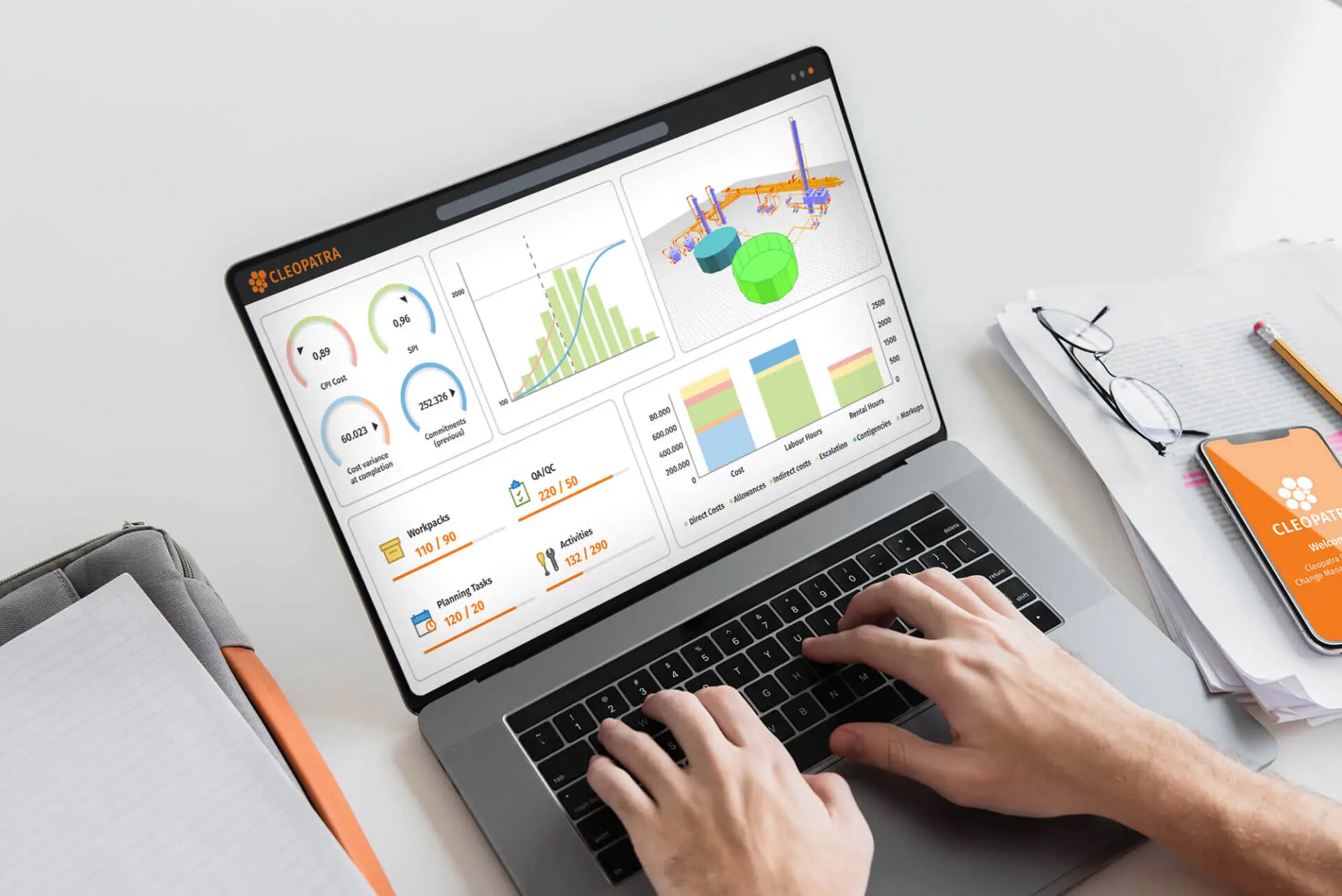
Operational efficiency in project management is about achieving more with less: delivering projects on time and within budget by minimizing waste, delays, and rework.
Improving efficiency isn’t just about cutting costs; it’s about streamlining work processes, anticipating issues, and enabling teams to focus on high-value activities rather than administrative tasks. This blog explores how project professionals can identify inefficiencies and implement practical strategies to enhance performance across cost, schedule, and quality.
Table of Contents
Conducting an Efficiency Audit
Operational efficiency starts with visibility. Before a project team can optimize, they must understand where inefficiencies exist. This is where an efficiency audit comes into play.
An effective audit examines current processes, identifies bottlenecks, and evaluates how resources (e.g., people, time, or capital) are being used.
The key steps are:
- Collecting data: Gather time sheets, change orders, budget reports, delay logs, and communication records.
- Mapping processes: Visualize workflows, especially in high-risk areas like procurement, approvals, and cost control.
- Identifying bottlenecks: For instance, procurement-related delays are often caused by manual approvals or poor coordination. An efficiency audit will be able to detect such bottlenecks and set the stage for automation and process changes.
Using Cleopatra Enterprise, teams can centralize these data sources and automate the extraction of key efficiency metrics. This can help pinpoint issues like rework frequency or delayed progress reporting.
Streamlining Processes and Workflows
Once inefficiencies have been identified, streamlining workflows and processes becomes the next logical step. This can involve simplifying procedures, reducing unnecessary handoffs, standardizing documentation, or automating repetitive tasks. By establishing more predictable and repeatable processes, project teams can reduce the risk of human error and minimize redundancies. Furthermore, by spending less time on repetitive tasks like updating spreadsheets or chasing approvals, teams can focus more on solving issues and delivering strategic value.
Here are some ways to streamline processes and workflows:
- Automate schedule and cost updates: By connecting scheduling tools with cost management systems, project teams can reduce manual data entry and enhance real-time forecasting accuracy. As tasks are completed, integrated systems can automatically update related activities, recalculate the critical path, and trigger alerts to affected stakeholders. This automation ensures better alignment between schedule progress and cost performance, enabling faster and more informed decision-making.
- Use standardized estimating templates:Using consistent estimating templates across departments ensures consistency in assumptions and scope boundaries. This makes it easier to validate, benchmark, and even reuse data for future projects.
- Automate change orders:Digitizing change request workflows with defined approval steps and integrated cost-schedule impact analysis can shorten review cycles and reduce project disruption.
- Centralize and automate reporting: Instead of manually compiling data from separate systems, pull data from centralized dashboards. This will save you time, all while improving transparency.
These improvements not only reduce effort and save time, but they also enhance accuracy, reduce the risk of rework, and improve overall operational efficiency. By reducing process variation and introducing automation where it adds value, organizations improve both speed and reliability. Advanced project controls software platforms, such as Cleopatra Enterprise, play a vital role since they offer the integration and automation needed to streamline complex project environments.
Project Integration and Platform Benefits

Improving individual processes boosts efficiency, but true operational excellence comes from connecting those processes. Fragmented systems, where schedules, costs, and risks live in separate tools, lead to conflicting data, manual reconciliation, and slow decisions.
A centralized capital project management software like Cleopatra Enterprise enables seamless integration from planning through execution, delivering key benefits:
- Eliminate data silos: Consolidating schedules, budgets, risks, and change logs in one system ensures teams work with consistent, accurate data. This reduces unnecessary delays and confusion.
- Support proactive decisions: Project integration connects the dots, providing a comprehensive and real-time overview of your project’s health. This allows you to identify and address potential issues before they escalate.
- Improve risk and change control: With connected data, assessing the full cost and schedule impact of proposed changes or new risks becomes faster and more reliable. Learn more about change control in project management.
- Increase transparency and alignment: Real-time reports keep all stakeholders informed and aligned, fostering better communication and trust.
By integrating data and workflows, platforms like Cleopatra Enterprise empower teams to work smarter, reduce inefficiencies, and drive better project outcomes.
Enhancing Communication and Collaboration
Operational efficiency also depends heavily on how effectively teams communicate and collaborate. Misalignment between departments or between the field and the office often leads to rework, delays, or missed opportunities.
Here are some key strategies to improve collaboration across the project lifecycle:
- Provide real-time access to information: Ensure all stakeholders can view and share critical updates on schedules, costs, risks, and progress. This helps avoid miscommunication and supports faster decision-making.
- Centralize communication: Centralize documents, approvals, and project discussions in one platform. This reduces email reliance, improves traceability, and keeps everyone aligned.
- Use standardized terminology: Establishing a common project vocabulary can minimize misunderstandings. This is especially important in organizations with distributed teams or frequent cross-project collaboration.
- Share information on a need-to-know basis: Transparency matters, but overloading teams with excessive or irrelevant details can cause disengagement. Focus on delivering targeted, meaningful updates to each stakeholder group so that they stay informed without being overwhelmed.
To facilitate communication, project professionals are increasingly relying on project controls platforms because they break down silos and create a shared understanding of progress and risks.
Monitoring and Interpreting KPIs

To improve operational efficiency, it first needs to be measured. That’s where key performance indicators (KPIs) come in, providing a feedback loop that informs project decisions and tracks progress against strategic goals. KPIs don’t just tell us whether a project is on track, but also how efficiently resources are being used and where corrective action may be required.
Consider these critical operational KPIs:
- Cost Performance Index (CPI): CPI measures cost efficiency. By measuring the value of work performed compared to actual costs. A CPI greater than 1 means the project is under budget, while a CPI below 1 signals cost overruns.
- Schedule Performance Index (SPI): SPI measures time efficiency by comparing the amount of work completed to the work planned. An SPI value above 1 signals the project is ahead of schedule, while a value below 1 suggests the project is behind schedule.
- Forecast Accuracy: Compares projected vs. actual costs and durations.
- Earned Value (EV): Quantifies the real value of work completed at a given point in time. When combined with planned value (PV) and actual cost (AC), EV offers a broader perspective on project health using earned value management (EVM) metrics like cost and schedule variance.
Don’t just report KPIs, interpret them to drive actionable improvements. For instance, a falling SPI may prompt deeper analysis into task dependencies, resource allocation issues, or process bottlenecks causing delays. Similarly, repeated forecasting inaccuracies may suggest flawed estimating practices, a lack of historical data, or unaccounted project risks. By understanding these signals, project teams can target improvements precisely where they’re needed most.
Tip: Monitor cost control KPIs in real time with live dashboards so that project teams can act quickly and address small issues before they impact your cost or schedule.
Feedback Loops and Continuous Improvement
By incorporating continuous improvement into project controls, teams can learn from experience, implement best practices, optimize existing processes, and refine future performance.
Here are some practices that support continuous improvement:
- Lessons learned reviews: Use project closeout reports to document post-project insights to prevent recurring errors and make them available for future use.
- Benchmarking: Compare performance across projects to identify the best practices and opportunities for improvement.
- Feedback channels: Instead of collecting insights at the end of projects, encourage teams to share insights throughout the project to drive timely adjustments.
- Structured knowledge management: Use integrated platforms to store and reuse historical data. This helps improve estimate accuracy, preserve knowledge, and implement lessons learned at various project levels.
Tip: Features like centralized registers, multi-level documentation, and reusable estimating datasets (as found in platforms like Cleopatra Enterprise) enable teams to track improvements, analyze trends, and avoid repeating past mistakes. This ensures organizations drive long-term efficiency gains.
Leveraging Technology and AI

To drive operational efficiency, project teams must make the most of available technologies.
First, it’s important to distinguish between automation and AI. On the one hand, automation streamlines repetitive tasks like updating spreadsheets or routing approvals. Thus, it reduces manual effort and frees up time. On the other hand, AI analyzes large volumes of data to identify trends, predict risks, and support smarter decision-making.
While automation allows teams to work faster, AI helps them work smarter.
Practical applications of AI in project management include:
- Predictive risk analysis: AI can flag early signs of cost or schedule issues by learning from historical project trends.
- Forecast accuracy: Machine learning enhances the precision of cost and schedule estimates as real-time data evolves.
- Resource optimization: AI models recommend efficient labor and equipment allocation based on progress and workload.
- Contract intelligence: Natural language processing (NLP) scans documents for risks or deviations, reducing review time and improving accuracy.
AI won’t replace project professionals, it empowers them. By adopting AI tools strategically, teams can eliminate waste, reduce delays, and make faster, more informed decisions throughout the project lifecycle.
Training and empowering your workforce
Tools and systems can only take a team so far. Operational efficiency also depends on how well people understand and apply them. That’s why training and coaching are critical.
- Role-specific training: Tailor instruction according to roles (e.g., cost engineers need different training than project managers or field supervisors).
- Practical workshops: Interactive sessions build familiarity with workflows, tools, and reporting structures.
- Establish a culture of efficiency: Empower your workforce to identify inefficiencies and propose improvements as teams closest to the work often have the best optimization ideas.
Whether through automation, better communication, or rigorous KPI tracking, operational efficiency is ultimately about enabling teams to do more with less while maintaining control, reducing risk, and improving outcomes.
Project professionals aiming to improve efficiency should start with transparency: understand where time, cost, and quality are being lost. From there, strategic improvements in workflows, technology, and culture can transform how projects are delivered.
If you have ever been involved in a project, you probably know how it usually ends. In the…
Effective project planning lays the groundwork for success yet challenges often arise beyond the initial blueprint. Among these…
Related resources

How to Improve the Owner-Contractor Collaboration in Construction
Learn how to overcome key challenges such as mistrust, data silos, and reactive planning to improve the collaboration between owners and contractors in construction projects.
Read blog article
An Earned Value Management (EVM) Guide
Scope creep, budget constraints, and aligning actual work with planned tasks are just a few of the challenges faced by project managers. Ever wondered how amid these obstacles project managers keep track of progress effectively? Earned Value Management (EVM) is their not-so-secret weapon. Understanding EVM's significance is crucial; it not…
Scope creep, budget constraints, and aligning actual work with planned tasks are just a few of the challenges…
Read blog article